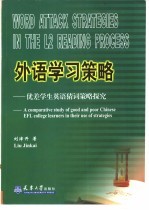

外语学习策略 优差学生英语猜词策略探究PDF格式文档图书下载
- 购买点数:10 点
- 作 者:刘津开著
- 出 版 社:天津:天津大学出版社
- 出版年份:2001
- ISBN:756181514X
- 标注页数:211 页
- PDF页数:222 页
Chapter1 Key research questions and factors to be investigated 1
1.1 Definition of Word Attack Strategies(WASs) 1
1.2 Key research questions for the study 1
1.3 Factors to be investigated-A preview 1
1.4 A bird s-eye view of the remaining chapters 3
Chapter 2 Rationale of the present Study:A review of some representative theories of second language learning 5
2.1 An overview 5
2.2 Theory of language learning:A psycho-cognitive perspective 7
2.3 Vocabulary learning (VL)-A contextualized perspective 9
2.4 L2 learning process:An information-processing approach 12
2.5 L2 reading process:A cross-linguistic perspective 15
2.6 Aspects of L2 learning in which factors to be investigated Belong 26
Chapter3 Review of the related research literature of language learning strategies 28
3.1 Study of WAS as one of the Language Learning Strategies(LLSs) 28
3.2 Role of WASs in Vocabulary Learning(VL) 28
3.3 Role of WASs in reading 30
3.4 WASs and the reading context 31
3.5 Strategy transfer and training 33
3.6 Characteristics of good/poor L2 learners 35
3.7 Summary:the importance of effective meaning-guessing strategies that make use of context for word attack 39
4.1 Proposed approach to the study of WASs 40
Chapter4 Theoretical framework:A proposed approach to WAS study,research questions and research hypotheses 40
4.2 Factors affecting WAS use 43
4.3 Research questions 50
4.4 Research hypotheses 54
Chaptert5 Research design,instrumentation,and data collection 57
5.1 Pre-experiment typology of WASs 57
5.2 Subjects 57
5.3 Experiments 59
5.4 Pretests 62
5.5 Procedures 63
5.6 Statistics tools for data analysis 64
Chapter6 Results for the subjects effective use of WASs in terms of guessing scores 65
6.1 Measurement for guessing scores 65
6.2 Results for the effect of group learner differences upon guessing effectiveness 67
6.3 Results for the effect of task variation upon guessing effectiveness 70
6.4 Results for the effect of time upon guessing performance 74
6.5 Summary and comparison of the results 76
Chapter7 Results for the Subjects use of WAS types 78
7.1 Results for the Subjects use of WASs in terms of WAS types 78
7.2 Results for group learner difference in WAS type distribution 85
7.3 Results for task variance in WAS type distribution 85
7.4 Results for instrumental influence on WAS type distribution 89
7.5 Summary and comparison of the results 92
Chapter8 Results for the Subjects use of WASs in terms of effective and ineffective clues 94
8.1 Measurement for analysis of WASs-RW(Right/Wrong clue)scale 94
8.2 Results for group learner variance in right/wrong clue choice 95
8.3 Results for task variance in right/wrong clue choice 98
8.4 Results for the influence of the instrumental variable upon good/poor learner differences in right/wrong clue choice 99
8.5 Summary and comparison of the results 103
Chapter9 Results for the subjects choice of clues in relation to their guessing scores 104
9.1 Measurement for analysis of clue-choice in relation to guessing scores 104
9.2 Results for group learner variance in choice of cRNW 105
9.3 Relationship between cRNW and guessing scores 107
9.4 Differences between good and Poor students in terms of their guessing scores in relation to their clue choice 110
9.5 Language task variation in the subjects choice of cRNW and in the cRNW/guessing relationship 114
9.6 Summary of the results 118
Chapter10 Results for the subjects group characteristics in practice,exposure,attitude and guessing habits 120
10.1 Measurement for survey analysis 120
10.2 Group characteristics in L2:Good students vs.Poor students 121
10.3 Group characteristics in L1:Good students vs.Poor students 125
10.4 Gomparison of group characteristics:L2 vs.L1 129
10.5 Relationship between guessing habits in textbook reading and guessing habits in non-textbook reading 132
10.6 L2 and L1 variance in guessing habits,reading purposes and attitude 134
10.7 Relationship between survey items and clue choice 150
10.8 Relationship between survey items and guessing scores 154
10.9 Summary and comparison of the results 158
Chapter11 Interpretation of the results-Answer to the 4 key research questions 164
11.1 Similarities:All subjects L2 WAS use vs. their L1 WAS use 164
11.2 Good/poor learner differences in L2 WAS use 165
11.3 Factors related to good/poor learner differences in L2 WAS use 167
Chapter12 Conclusions,implications and recommendations 176
12.1 Conclusions 176
12.2 Limitations and recommendations 182
Appendix Ⅰ. Experiment Sheets(Experiment Version) 183
Appendixes 183
Appendix Ⅱ. Experiment Sheets(Non-experiment Version in English) 192
Appendix Ⅲ. Warming-up Exercises(Experiment Version) 203
Appendix Ⅳ. General WAS Type Distribution 204
Appendix Ⅴa. General WAS Type Distribution:L2 Tasks 204
Appendix Ⅴb. General WAS Type Distribution:L1 Tasks 205
Appendix Ⅴc. General WAS Type Distribution:Overall Tasks(L2+L1) 205
Appendix Ⅵ. General WAS Type Distribution(Weighted) 206
Appendix Ⅶ. General WAS Type Distribution(Weighted,Think-aloud Tasks Only) 206
References 207
- 《外语学习策略 优差学生英语猜词策略探究》刘津开著 2001
- 《外语学习动机激发策略的理论与实证研究》王志敏著 2015
- 《外语学习策略理论与实践研究》肖巧萍著 2013
- 《大学外语学习策略》宋力英著(哈尔滨商业大学外语学院) 2007
- 《外语学习策略与方法》潘亚玲著 2004
- 《外语自主学习策略教程》曾洁主编 2011
- 《外语学习策略研究》刘振前,肖德法主编 2006
- 《学习策略训练与外语听力教学》 2222
- 《汉语作为外语学习的研究 认知模式与策略》徐子亮著 2010
- 《外语学习策略和学习风格的实证研究》蒋国东著 2013
- 《外语学习策略 优差学生英语猜词策略探究》刘津开著 2001
- 《英语交际法教学示例》张淑琴,刘津开编著 1991
- 《中学英语任务型教学理念与教学示例》程可拉,刘津开编著 2003
- 《大学英语阅读策略训练》刘津开主编 2006
- 《英语猜词策略 词汇量扩大攻略》刘津开编著 2002
- 《天生赢家》刘津编译 2003
- 《珍妮姑娘》(美)德莱塞著;刘津伊译 2001
- 《博客传播》刘津著 2008
- 《认识自我》刘津编译 2003
- 《土木工程施工》刘津明,韩明主编 2001
- 《日本占领天津时期罪行实录》郭登浩,周俊旗主编 2016
- 《天津通志 出版志》天津市地方志编修委员会编著 2001
- 《天津出版史料 第2辑》孙五川等主编 1990
- 《天津出版史料 第1辑》孙五川,林呐主编 1988
- 《天津市出版科研论文集 2006》天津市出版工作者协会编 2007
- 《天津人民美术出版社藏画选》 1984
- 《天津人民美术出版社藏画 陈少梅 第2版》陈少梅绘 2008
- 《嘛叫天津人 历史篇》孙福海著 2017
- 《天津年画百年》张道梁编 2004
- 《天津人民美术出版社藏画 任伯年》任伯年绘 2004
